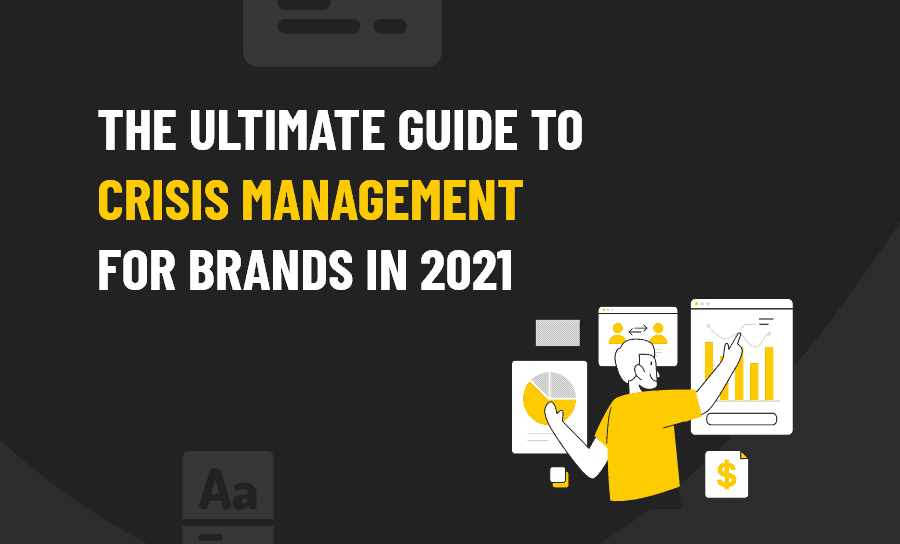The way a company handles itself in the face of crisis is reflective of its strengths and longevity. A well-crafted crisis management plan is like finding a jackpot – with the right people by your side to help you manage and work through it; it’s all the luck you need.
Crises are of various kinds – existential, man-made, business. In this monster guide, we will cover everything you could possibly need for the latter.
Buckled in? Let’s go.
What is a Crisis?
Simply put, in a business crisis, the health and success of the company are threatened. These can be intangible threats in the form of data breaches or tangible, like natural disasters.
Irrespective of the scale of the business, a crisis can be defined by problems that are affecting the normal course of operations of the business.

These could include events such as a sabotage attack by adversaries causing tarnished reputations, negatively impacting finances, harming employees, the death of a CEO, or other organisational setbacks. This also relates to an exposure to cybersecurity attacks.
Typically, these crises take form unannounced and need to be dealt with as a matter of urgency. Due to this, crisis management plans are usually sketched up long before they occur and cover all potential threats.
Types of Crisis
A crisis can either be self-induced or caused by external forces.

Self-inflicted crises occur within the organisation. They can include emissions or smoke releasing hazardous chemicals, cyber-attacks, ransomware attacks caused by the IT department’s ineptitude (which would be a good reason to use an outsourced IT provider), or even offering poor customer service that goes viral online.
Examples of external forces which are beyond an organisation’s control include natural disasters, security breaches, or false information about a company that hurts its reputation or PR blunders.
Unlike most external crises, internal crises can be managed, mitigated, or avoided if a company enforces strict compliance guidelines and protocols regarding ethics, policies, rules, and regulations among employees and management.
Just like your health is insured in cases of unforeseen abnormalities which need to be attended to in a matter of urgency, businesses too can be insured, through Crisis Management Coverage.
In more specific terms, crises could potentially take a toll on specific business areas. In this case, developing crisis management plans concerning the different categories of crises which businesses are most susceptible to experiencing should also be given consideration:
Financial crisis: When a business experiences a plummet in demand for the product or service that they’re selling. In such situations, assets lose value, and the business is unable to pay off their debt. That’s why an inventory management software such as BigCommerce eBay integration, Wix Etsy Integration is required to take charge of your stock control and prevent a business financial crisis. In this ultimate guide you may know how to get out of debt?
Personnel crisis: When an employee or someone associated with the business is involved in an activity or conduct that’s considered unethical and/or illegal. This misconduct may occur in or out of the workplace and can be related to the individual’s work-life or personal life.
Organisational crisis: When a business has wronged their customers by taking actions that negatively impact their customers. Examples may include keeping vital information from customers who deserve to know the details about a specific topic or exploiting customers.
Technological crisis: When the intranet or servers crash, software glitches, or another technological system stops functioning properly. It might cause the business to lose large amounts of revenue, make customers question their reliability, or tarnish their reputation.
Natural crisis: Hurricanes, tornados, floods, and winter storms are all examples of natural crises that have the power to damage or completely ruin a business’ office space (or any area owned or used by a business). Depending on a company’s location, they might be more prone to various natural disasters occurring throughout the year.
Impact of Each of these Crises
Once you’ve identified the crises that could likely impact your business, determining the impact each of these events could have on your company, employees, and customers is the next crucial step.
It’s often this step of being prepared and aware of the pitfalls which the business might suffer that makes the most difference and creates a well-rounded crisis management plan.
Examples of the kind include:
- Loss in sales
- Customer dissatisfaction
- Tarnished reputation
- Increase in expenses (to fix the issue at hand)
- A decrease in customer loyalty to your brand
By quantifying and systematically analysing the impact each crisis could have on your business, you’ll be able to understand and compare each possible angle of threat or catastrophe and, therefore, prepare for it appropriately, or even overcome it.
This type of review will lead you to determine the appropriate actions you and your fellow employees need to take to resolve each event.
Crisis Management Coverage
As businesses have globalised and embraced digital evolution, so too have its threats. Exposure to cybersecurity attacks, terrorism, travel risks, kidnap and ransom, product contamination, supply chain and product distribution disruption, and adverse media coverage has amplified, redefined, escalated the gravity of threats to an unprecedented scale.

Crisis management coverage, to a considerate level, can cushion the damage caused by many threats and crises. These can extend from local PR blunders such as the drunk driving arrest of a prominent board member to more serious threats such as massive breaches of customer data or vicious computer network attacks.
Crisis management coverage comes in super helpful in this respect by providing services which include threat assessment, impact analysis, crisis management and response.
Crisis management coverage is insurance coverage designed specifically to help businesses limit the negative impact of events that may affect their reputation.
It is typically an insurance agreement made as part of technology errors and omissions (E&O) and Internet/online property and liability insurance policies.
Different insurance policies will cover specific hazards but may include events like data breaches, kidnapping, negative headlines, and workplace accidents.
Large corporations are often the most frequent buyers of crisis management coverage; however, businesses whose profitability is closely linked to their reputation are a potential customer.
Due to the unpredictability factor of global events, organisations must be equipped to be able to cope with the potential for drastic changes in the way business is conducted and crisis management coverages allow to overcome just that.
Since crisis management often requires decisions to be made within a short time frame, and long after an event has already taken place, crisis management plans are created to reduce the uncertainty in the event when the crisis actually occurs.
Types of Crisis Management Coverage
The content and benefits lined out in the crisis management coverage can vary across the different types of insurances policies they cover.
Some of these policy coverages may include paying for various types of consultants, such as communications professionals, to assist the policyholder in identifying and executing a strategy to limit any further impact of the event in the media, cover damages caused by an inside job or employee sabotage, violence, assault, firearm use, food contamination, and workplace accidents.
The coverage may be and are usually triggered by news media coverage of the event, whether in regional forums or national forums and will typically apply for a set period of time, such as 60 days, after a crisis event occurs, and be subject to an aggregate limit.
You can use the Situational Crisis Communication Theory (SCCT) to help you develop this response strategy, so your business is ready to handle any unforeseen event.
The Situational Crisis Communication Theory (SCCT)
The Situational Crisis Communication Theory (SCCT) identifies potential response strategies that organizations can use to handle crises. It’s based on who was responsible for causing the crisis as well as how significant the threat is to the business’s reputation.
SCCT outlines the path for crisis communication and determines the actions the crisis management teams will take based on the situation. Not only is SCCT based on the organization’s understanding of the crisis, but also on their preconceived notion of how stakeholders will respond to each type of response.
Rebuilding Strategy
This strategy aims to rebuild and renew relationships primarily with stakeholders by redeeming the organization’s reputation. This is usually achieved by taking responsibility for the crisis and offering apologies or compensation to those affected by the incident.
Rebuild crisis strategies are most frequently used in response to accident crises, especially when the organization has had a history of similar crises and/or has developed a negative reputation in the past.
Rebuilding strategies should also always be considered for preventable crises where stakeholder relationships may be permanently damaged. While it may take more time to rekindle the relationship, these actions within the rebuilding strategy will mark the first step towards that recovery.
Diminish Strategy
This strategy aims to minimize the amount and extent of responsibility placed on the organization. This is achieved by offering reasons for or justifying the company’s actions.
Diminish crisis strategies are most frequently used in response to victim crises where the company is not at fault for the issue. If used in response to accident crises, diminish crisis strategies should be used when the organization has had no history of crises and has a relatively positive industry reputation with respect to the crisis. For smaller crises, this strategy can help businesses minimize the negative effects of the situation while still avoiding taking unnecessary fault.
Deny Strategy
This strategy completely re-assigns the blame away from the organization. This is achieved by confronting the accuser(s) for their invalid accusations, claiming that there is no crisis, or blaming another party, the one truly responsible, for the crisis.
Deny crisis strategies should be used in victim crises when the organization is faced with rumors or accusations that are harmful and untrue.
Rather than rebuilding the relationship, it’s best to confront the cause of the crisis immediately to avoid further escalation of rumours and gradually of the crisis.
It’s important to keep in mind that this strategy is only effective if your business is truly at no fault for the situation.
Bolster Strategy
This strategy works to position the organization as an asset to its stakeholders. This is achieved by reminding stakeholders of its former good deeds and praising stakeholders for their dedication and loyalty.
Bolster crisis strategies can be used in conjunction with other primary crisis strategies, especially when the organization is faced with victim crises.
While each of these strategies are predicted to be effective in the specific crises laid out, it’s impossible to know exactly how stakeholders -and the overall public -will react to an organization’s chosen response.
So, it’s important to prepare not only for the public’s response to the crisis but also for their response to your follow up actions.
How SCCT Helps Your Business
At this point, you may be wondering how SCCT will actually help your business in the long run. Fortunately for you, simply tailoring each crisis communication strategy to the specific crisis at the moment can save you time and headaches by ensuring a smoother crisis response when and if your business faces a crisis.

With regards to short-term and long term-responses, below are a few examples of the benefits SCCT can provide for your company:
Helping you practice and prepare for crises in advance
The emotional and mental stress caused by crisis situations are undebatable. This is exactly why SSCT is important and so helpful, they prepare you for the absolute worst, and help you come out strong.
You never want to go into a crisis blind without having ever prepared for it. This is why it’s important to role play with your team using example case studies. Everyone on your crisis communication team should be on the same page about how to immediately handle negative events that impact your organization.
Having done your research on the potential causes of the crisis and practised ways to deal or combat them is going to be far less strenuous for you as you will be performing at the best of your ability.
Less likelihood of panicked decisions during the crisis
It’s easy to panic when facing a major crisis, especially if it’s one you didn’t see coming. Your nerves get the best of you, you’re feeling discouraged by slashing comments on social media, and the pressure gets to your head. This is usually a recipe for disaster and panicked, hasty decisions in the absence of a crisis management plan resulting in a last-minute, unplanned response that makes matters worse.
However, when you know that you have crisis strategies laid out by SCCT, you can be a lot more relaxed knowing you don’t have to come up with the proper response to your crisis completely from your imagination with strict time constraints.
Rather, you can reference your existing SCCT strategies to come up with a plan of action for an unexpected crisis.
It helps you categorize each crisis, making it easier to handle
SCCT makes you categorize your crisis into one of three types: victim, accident, or preventable.
Even if you don’t have a specific plan for the situation at hand, this categorization gives you a baseline to work off of. Having that starting point to work from will make you feel like you’re taking action to resolve your crisis, rather than waiting and wondering what to do next.
It reminds you to prioritize the public opinion
It’s vital that a company doesn’t prioritize its own needs when responding to a crisis. Just as in any organizational action, the focus is on the customer’s success, not the organization’s.
You may believe that the best way to respond to a crisis is to immediately deny the accusations and protect your organization’s reputation. However, what do your stakeholders want to hear? What’s going to make them trust you again? Sometimes, that means putting aside your pride and taking responsibility for your actions, in the hopes that your honesty will regain their loyalty.
What is Crisis Management?
Crisis management is the process of preparing for and managing any disruptive or unexpected emergencies that affect the business, stakeholders, employees, customers, and revenue.

While it may primarily include the way the actual crisis is dealt with, it is generally drawn up by keeping in mind the three steps of:
Pre-crisis
The initial crisis response guidelines focus on three points: (1) be quick, (2) be accurate, and (3) be consistent.
The primary step to crisis management is to prevent all potential crises- through a carefully drafted crisis management plan complemented with quick responsive action. This includes noticing potential loopholes or circumstances which may turn into one and prepping for them in advance or, even better – knocking them off as soon as possible.
The business must respond to the crisis in the first hour that it occurs. Arpan and Rosko-Ewoldsen (2005) conducted a study that documented how a quick, early response allows an organization to generate greater credibility than a slow response.

The rationale behind being quick is the need for the organisation to tell its side of the story before others get a chance to spin it around.
The response includes key points the management wants to convey about the crisis to its stakeholders and onlookers to avoid any information vacuum from being created.
If mistakes are made, they must be corrected but inaccuracies in the first hour of response, make the organisation look inconsistent. The philosophy of speaking with one voice, i.e., is a way to maintain accuracy.
However, a single voice does not apply to a single, individual company representative; but rather the single voice of the public relations department.
It’s pertinent for the crisis team to share information so that different people within the PR team can convey a consistent message. The spokespersons should be briefed on the same information, covering the key points the organisation is trying to convey in the messages or the broadcast address/press releases.
The public relations department should be instrumental in preparing the spokespersons. Ideally, potential spokespersons are trained and practise media relations skills prior to any crisis, and the focus rests on how the information should be delivered rather than how to handle the media.

More recently, crisis experts have recommended a third component to an initial crisis response, where crisis managers express concern/sympathy for any victims who have been inconvenienced in some way by the crisis. This may include lost money, health hazards, evacuation, or suffered property damage.
When the crisis results in serious injuries or deaths, crisis management must include stress and trauma counselling for employees and other victims.
One illustration is the trauma teams dispatched by airlines following a plane crash. The trauma teams address the needs of employees as well as victims’ families and pool all their resources towards providing the resources needed to help these groups cope.
The pre-crisis stage also includes drafting responses or communication for events following the crisis; it often saves time and makes the process more efficient.
Pre-draft Messages
Crisis managers can pre-draft messages that will be used during a crisis for efficiency purposes. More accurately, crisis managers create templates for crisis messages.
Templates include statements by top management, news releases, and web sites.
The templates are general messages which can be used to address specific issues using the blank spots where essential information is inserted once it is known.
Public relations personnel are usually responsible for drafting these messages, and the legal department pre-approves them.
Initial Crisis Response Best Practices
- Be quick and try to have an initial response within the first hour
- Be accurate by carefully authenticating all facts
- Be consistent by keeping the spokespeople informed and updated with crisis events and key message points
- Make public safety and opinion the number one priority
- Use all of the available communication channels including the Internet, Intranet, and mass notification systems
- Provide some expression of concern/sympathy for victims
- Remember to include employees in the initial response
- Be ready to provide stress and trauma counselling to victims of the crisis and their families, including employees in case of severe crisis threats

Crisis Response
This includes going-into damage control mode and responding to the different stages of the crisis itself.
This is the bane of your understanding of the crisis, and your crisis management plan is put into action.
This is also when your previously drafted crisis management messages are released, employees and stakeholders and contacted, and public, and company safety is prioritised (more than otherwise during normal situations).
Post-crisis
Apologies in advance if you thought you now sit back and relax and expect going back to the usual course of business. In fact, far from this.
Post-crisis involves remaining in contact (more than usual) with your employees, customers, and stakeholders and remaining available to answer questions and provide proactive updates.
The amount of follow-up communication required depends on the amount of information promised during the crisis and the length of time it takes to complete the recovery process.

If you promised a reporter a damage estimate, for example, be sure to deliver that estimate when it is ready. For instance, West Pharmaceuticals provided recovery updates for over a year because that is how long it took to build a new facility to replace the one destroyed in an explosion.
The most important part of post-crisis management involves reflecting, analysing, and looking for avenues to learn and take back from to avoid similar consequences in the future. Integrate any lessons you learn into your crisis management process for future planning.
Crisis managers agree that a crisis should be a learning experience. The effort needs to be evaluated to see what is working and what needs improvement, and the same holds true for exercises.
The organisation should seek ways to improve prevention, preparation, and/or the response.
This is usually done with the health of your crisis management team of experts and reviewing how it played out during a real emergency.
Post-Crisis Phase Best Practices
- Deliver all information promised to stakeholders as soon as that information is known.
- Keep stakeholders updated on the progression of recovery efforts, including any corrective measures being taken and the progress of investigations.
- Analyse the crisis management effort for lessons and integrate those lessons into the organisation’s crisis management system.
Now, let’s dive into the crisis management plan and how to create one for your business.
Before we dive into drafting a well-rounded crisis management plan, let’s understand the difference between crisis management and risk management.
Types of crisis management
To determine the necessary actions you and your business, employees, contractors and anyone else associated with your business or crisis may need to follow or be equipped with, review the different crisis management methods you could implement. A few of the most common crisis management methods include the following:

Responsive crisis management: This is when a business has a previously prepared response to a specific type of crisis that they can roll out at any point in time. Response crisis management is the likely consequence of a crisis management plan which was put in place long before the crisis occurred, but the potential for it to occur was identified.
For example, a business might have specific steps in place for how they would manage an organisational or financial crisis promptly. These plans might also detail the process in which would inform the employees and stakeholders about the event to stakeholders and undertake necessary actions as lined out in the crisis management plan.
Proactive crisis management: This is when a business anticipates a specific type of crisis occurring and proactively prepares for it.
An example of this would be related to the potential of a natural crisis — a business located in Tokyo, Japan that has recently discovered avenues of profitability there, might ensure the office space is built to handle hurricanes and severe storms.
Recovery crisis management: This is when a business manages a crisis that blindsided them because it occurred out of the blue.
An example of this is a technological crisis, such as a data security hack. Suppose a business’ data protection software is working perfectly one moment and unexpectedly crashes another, causing the hacker to steal and misuse customer information. In that case, it impacts employees in addition to customers who use the software.
In the process of identifying all crises your business is susceptible to, you may also decide to develop a business continuity plan at this point in time.
This will help you identify all potential aspects of these crises on a very detailed and informed level as you work through the rest of your crisis management plan steps.
The Crisis Management Team
Crisis management teams are created to protect your business from the adverse effects of any crisis situation or event. They also help keep your business and employees prepared for any threats that could potentially come your way.

Once you’ve considered the impact of each type of crisis and the actions you’ll take to resolve them, it’s time to deliberate over and select the people who are best suited to carry out the necessary resolution plans and actions.
This often includes specific employees with expertise in different areas of your business, HR, public relations, and anyone else you see fit based on your specific situation, creating a crisis management team of professionals within the business to deal with all sorts of crises proactively or even hiring third-party experts.
Depending on the type of crisis, you might also determine you need the assistance of lawyers, consultants, or first responders.
Some of the main job functions of a crisis management team include:
- Detecting warning signs or any unusual abnormalities that signal that a crisis is coming
- Working with employees and other related or affected parties to prepare for and handle the implementation of a crisis management plan
- Ensuring the reputation of your company remains positive throughout (and after) any crisis event
- Helping your business prepare for any future crisis situations
There are three types of crisis management teams your company might hire to help you manage a situation.
These teams include regional emergency management teams, site emergency response teams, and business support teams.
Regional Emergency Management Teams
Regional emergency management teams provide support to local areas throughout a crisis situation. This team will aim to manage the region-specific effects of a crisis by providing assistance in the form of advice, shelters, etc., depending on the size of your business and your various office locations (if you have them). This type of team is typically made up of people who live and work in the area already.
Site Emergency Response Teams
Site emergency response teams manage the scene of crisis directly when called upon (if they’re not already there when the situation unfolds). The people on this type of team include on-site employees, first responders, and local officials.
Business Support Teams
Business support teams manage the impact a crisis has on a business as a whole – on the back and front ends. It’s a team often composed of employees who ensure all management plans are fulfilled to resolve the crisis. Business support teams might include employees from a number of different locations and/or offices.
Questions You Should Ask Before Making A Crisis Management Plan
You now have all the potential causes of setbacks your business could suffer and have the means to act or even completely get rid of them.

You are now all set to be able to develop appropriate resolution plans for each type of crisis. However, make sure you consider the following questions before, or while developing any type of crisis resolution plan:
- How long will it likely take to resolve the crisis?
- What is the true extent of the damage done?
- What tools and resources will you need?
- Is there an internal way of approaching this without going public?
- How big are the losses the customers have suffered?
- Are the first-responders efficiently briefed?
- How many people, and which people, will be involved?
- Will you need to address your customers directly?
- What is the cause of the crisis and how can you prevent it from happening again (or from worsening?)
- Can a similar crisis be prevented in future? If not, what are the resources or plans of action to overcome that?
Why You Should Create a Crisis Management Plan
If your business’ profitability is closely linked to its reputation, being unequipped with a crisis management plan detailing how you’ll handle a crisis, it’s very likely to cause you and your business serious and long-lasting consequences.

These consequences might lead to various legal, operational, and public relations issues and depending on the extent of the damage, a crisis situation, especially ones you aren’t prepared for could even put you out of business.
Simply put, all businesses should have a crisis management plan in place to be prepared for any unplanned event and prevent any long-term damages.
There are four other main reasons why you should ensure your business has a crisis management plan.
- Help you maintain your great reputation with customers, competitors, and industry leaders during and after a crisis.
- Improve the safety, health, and well-being of everyone who works for and does business with your company.
- Give you peace of mind as an employer and company — you’ll be ready for any situation that comes your way.
- Increase productivity during and after a crisis. Everyone will know their role and function throughout a crisis, so there’s less downtime, more action, and quicker resolution.
Crisis Management vs Risk Management
Risk management refers to the process of identification, analysis, and management or mitigation of uncertainty, usually in investment decisions.
Unlike risk management, which involves planning for events that might occur in the future, crisis management involves preparing to deal with negative events during and after they have occurred.
While risk management allows for planning of risks which rest in the future, crisis management can unfold only after it has occurred. A crisis management plan simply allows for better response actions to uncertain potential crises once they have occurred.
An oil company, for example, may have a plan in place to deal with the possibility of an oil spill since it was always running the risk of spilling it. They must do everything within their power to avoid it. However, if such a disaster actually occurs, the crisis management team gets into action to respond to the backlash of public opinion, and the cost of cleanup etc. can vary greatly.
Creating A Crisis Management Plan
A study by Deloitte reveals that 51% of organisations do not have a crisis management plan, and if you’re reading this, you are already on the right path!

While this may appear as a daunting task, all it requires is to know your business and all associated variables inside and out. This is how you start:
Risk Assessment
As the name suggests, the risk assessment step identifies potential issues and crises that would disrupt your business function and/or processes. Usually, it involves brainstorming with members of leadership, your crisis response team, and other key stakeholders to begin listing all relevant threats and vulnerabilities that could impact the organisation.
Potential risks can be found in public relations blunders, social media gaffes, product recalls, cyberattacks, workplace issues, and extreme weather events such as earthquakes, floods, etc.
Determining The Extent Of Impact On Business
Characterised by Business Impact Analysis (don’t worry, we’ll cover this soon), this step of your crisis management plan identifies and predicts the potential impact of a business-disrupting issue and gathers the required information to develop recovery strategies.
Apart from revealing the extent of problems you could face across your organisation, BIA helps you consider every threat’s angle.
Potential Impacts Of a Crisis
Some impacts that could be considered include:
- Loss of sales and income
- Delayed sales or income
- Regulatory fines
- Increased expenses (e.g. overtime labour costs)
- Contractual penalties or loss of contractual bonuses
- Customer dissatisfaction or defection
Timing and Duration Of The Crisis
When your business function or process is disrupted, the duration can have a significant bearing on the loss sustained and ultimately your crisis management plan.

For example, an unfortunate fire in one of your warehouses just before the holiday season may result in a substantial loss of your annual profits. On the other hand, a two-minute power outage may not be as bad of a crisis when compared to an outage that lasts for hours.
A short-spanned disruption in the usual course of business such as by a two-minute power outage may be overcome by installing emergency generators. But the disruption of a warehouse during high demand circumstances could have a significant impact.
Conducting The BIA
Using this BIA questionnaire to survey your managers and others within the business will be your first step to assess potential risks from all angles.

Capture survey responses from people who have a detailed knowledge of how the business operates as a whole. Ask them to identify the potential impacts if the business function or process that they are responsible for is interrupted. Encourage them to identify the critical business processes and resources needed for the business to continue to function at different levels.
The BIA Report
The BIA report should document the impacts resulting from the disruption of business functions and processes. The scenarios resulting in significant business interruption is ideally assessed in terms of the tentative financial impact.
The BIA report should also prioritise the order of events that would follow as restoration of the usual course, with operational and financial impacts at the top of your list.

Business Disruption Scenarios
While the BIA formulation is independent of the nature of business disruption, you might want to consider a couple of scenarios which could essentially start you off with some of the following points for your crisis management plan:

- Physical damage to buildings
- Equipped with rented office space for use in case of emergencies
- Encouraging employees to work from home, depending on the intensity of the damage caused and deadlines your business is expected to meet
- Restricted access to a site or building during times of emergency
- Every individual who has unrestricted access to the building or site should have at least a couple of spare keys
- In case these individuals cannot be reached, spare keys of all priority rooms and sites can be stored within a specific room in the office building
- Damage to or breakdown of machinery, systems or equipment
- Keeping extra machinery, systems or equipment which are routinely serviced
- Arranging an in-house team of mechanics to attend to machine failure
- Interruption of the supply chain including failure of a supplier or disruption of transportation of goods from the supplier
- Order more than what’s required to compensate for defective goods during rush hours
- Alert all concerned parties about the delay and assist the supplier in overcoming the setback
- Utility outage (e.g., electrical power outage)
- Emergency generators
- Arranging an in-house team of electricians to attend to power failure
- Damage to, loss or corruption of information technology including voice and data communications, servers, computers, operating systems, applications, and data
- Power your firewall with powerful technology to protect user data
- Proactive IT team who can assess the damage and advice you on the best course on overcoming it
- Absenteeism of essential employees
- All employees could keep a record of what they have been working on and share it all on a shared (yet password protected) online cloud service which can be accessed by another
Crisis Preparation Best Practices
- Have a crisis management plan and update it at least annually
- Have a designated crisis management team that is properly trained
- Conduct exercises at least annually to test the crisis management plan
- Pre-draft select crisis management messages including your templates for crisis statements
- Have the legal department review and approve your plan of actions and recommend necessary changes
Spokesperson Training
A key component in crisis management involves the crisis team being equipped with professional spokesperson training involving staff members trained and prepared to talk to the news media during the crisis.

Crisis Media Training Best Practices
- Phrases such as “no comment” should be avoided since it may imply that the organization is guilty and trying to hide something which may not be the intention.
- Present succinct information by avoiding jargon or technical terms. Lack of clarity makes people think the organization is purposefully confusing and is perceived as a sketchy tactic to hide something.
- Appear pleasant on camera by avoiding nervous habits such as shaking your hands and feet, playing with your fingers and the like since it may be interpreted as deception.
Ideally, a spokesperson needs to have strong eye contact, limited disfluencies such as “uhms” or “uhs”, and avoid distracting nervous gestures such as fidgeting or pacing.
- Brief all potential spokespersons on the latest crisis information and the key message points the organization conveys to stakeholders and the media.
- Public relations plays a critical role in preparing spokespersons for handling questions from the news media.
The public relations personnel can provide training and support because they are not the spokesperson during the crisis.
Stages of a Crisis
Along with the creation of your crisis management plan, it’s equally important to understand and be aware of the different stages of a crisis which will eventually influence the way your crisis management plan unfolds.
These stages occur during a crisis and can help you determine how you should respond to the situation at different times.
(Note: You should ensure you have all of your crisis management plans in place before working through the stages of a crisis in a real situation.)
Warning
Although you cannot always predict the timing of a crisis, there are often signs you can keep a lookout for that serve as a warning. These warning signs can be related to a wide range of factors such as employee behavior, weather patterns, or company finances.

Risk Assessment
The risk assessment stage begins immediately after a crisis starts to unfold. It’s when the key players at your company (likely the ones entrusted to deal with the crisis) begin assessing the impact the crisis might have on your business, employees, and customers.

During this stage, the potential consequences of the crisis, plausible damages, and resulting problems are discussed and effectively analysed. This way, everyone involved is aware and prepared for the worst possible scenario.
Response
Once you study the level of risk associated with the crisis, you and your team will compare and decide which crisis management plan you want to implement as the best course of action. Then, everyone involved — including your employees, customers, and emergency response teams (if necessary) — can be notified of the situation.

The response stage involves a lot of communication to both inform everyone of the crisis and kickstart the various actions that will be taken to manage and mitigate the incident.
Management
Next comes the management phase. This is when everyone involved in rectifying the crisis comes forward to work on managing and carrying out the chosen resolution plan, the immediate effects of the event, and any unexpected or worsening effects that may arise.
This stage involves the same type of open communication that you used in the response phase to ensure all employees, customers, and stakeholders are up to speed on the state of the business including all progress or otherwise.
Resolution
During this phase, everyone involved in resolving the crisis should have fulfilled (or nearly fulfilled) their given duties. The crisis should be pretty much under control at this point. It’s also the point when all of the necessary plans and actions to go back to your business normalcy are initiated.
Recovery
As you leave the resolution phase and move into recovery, your resolution plans are well underway, and your business is getting back on track as it recovers from the crisis it endured.
This stage includes getting all employees back into their day-to-day operations and ensuring that your customers are set up for success with your product or service once again.

It’s very important to analyse the results of your crisis management plan during the recovery phase. This way, you can determine how you feel the situation was managed and how you plan to avoid another similar situation from happening in the future.
To help you work through your crisis management plan as well as the stages of a crisis, you might determine that hiring or working with a crisis management team is the best option for your company.
Identify Contingencies
Now that you have roughly determined the risks that could impact your business and how your next step should consist of identifying the actions that will help your organisation to respond effectively to each threat and bounce right back.
It might be most helpful to think about the steps that would help you resolve the issue, the resources which you could put to use, and how your employees can be of help.
For example, in response to a cyberattack, delegate tasks across your IT, PR and customer service teams. Asking them to take proactive responsibilities through effective efforts to minimise the effect of the attack, issuing statements across all media or briefing on what to say on incoming calls to protect the company’s good standing, would be the recommended and contain the crisis.
Build the plan
After determining the contingencies for each potential threat, get into fleshing it out by working with the stakeholders.
As previously mentioned, key employees, such as department heads, can provide actionable insights into available resources and potential hurdles.

Complementing insider information with inputs from outside parties, such as sponsors, partners and the like that work closely with your business could also help develop a multi-faceted plan.
Ensure that all relevant regulatory requirements are considered and ensure ways in which you are to continue to meet them, even in the midst of a crisis.
For example, if your organization must remain compliant with the Health Insurance Portability and Accountability Act of 1996 (HIPAA), be sure to account for this in the crisis response plan.
Brief each participant of crisis management about their role
It is imperative that all employees understand their roles, what’s expected of them during a crisis and are trained on the role they’re expected to play. Since stress and panic can make it difficult to remember roles during a crisis response, running drills and rehearsals should help overcome it.
This can be done by ensuring that your employees have all the adequate necessary information they need. During the tense moments, it’s likely that people will want and require immediate access to straightforward information.

Role training can be achieved through meetings and presentations, or bring in experts to chat with your employees about managing their job functions during a crisis.
Consider ways to quickly and effectively distribute a crisis e-playbook, such as through an internal crisis management app, including real-time access to up-to-date documents, incident reporting, contact lists, messaging capabilities, and collaboration tools. Also, be sure to frequently train stakeholders on your issue and crisis management plan. Training can range in many forms it can be through material distributions, by hiring a private instructor with a solid coaching contract template and invoicing system.
All employees – those who may or may not play a role in resolving a given crisis -yet will still be impacted by its occurrence -should be informed of the actions they’re expected to take as well.
For example, if your employees are situated in a location prone to natural disasters, training everyone at your company on safety-related actions to take through drills informing them where to take shelter is critical. The last thing you’d want is for one of your employees to be hurt in a crisis due to lack of preparation and training.
Ensure that every individual is familiar with the plan, can respond confidently, knows where to get additional information, and understands their role.
Routine Plan Revisal
After multiple brainstorming sessions, hit-and-miss trials, and multiple testings, your foolproof plan needs to be formally written and approved.
However, your work here doesn’t stop here either.
Be sure to revisit it frequently to rehearse it to a tee at the time of execution, i.e. at the time of crisis. It is vital to keep the plan up to date, especially as employees join or leave the company, new technologies are implemented, and other changes occur. Routine and frequent plan reviews and tests will keep the content robust.

If you do go through a crisis, be sure to analyse the results of your management plans to determine whether or not they were successful in pulling your company through — you might decide they need to be updated or reworked completely.
The Crisis Management App
I have mentioned my preference for an internal crisis management app before and will do so again because of how effective they can prove to be during the crisis.
Using an app provides a platform which automatically pushes all updates to each user’s smartphone, so, rest assured, all relevant members of the organisation and stakeholders have immediate access to the most up-to-date resources, no matter when they require it.
If a PR nightmare or a product disaster makes it your way on a Sunday afternoon, your team still has immediate access to the information to activate the response.
While crises begin as a negative/threat, effective crisis management can minimize the damage and in some cases, allow an organization to emerge stronger than before the crisis.
Conclusion
Pearl Lemon’s awesome team of crisis management experts can not only help you understand the potential crises your business could suffer, but more importantly, help you build a crisis management plan tailored to your needs.
Across businesses and entrepreneurs, our PR team will support you through Reputation Management as well as Content Writing!
No organization is immune from a crisis so all must do their best to prepare for one. This comprehensive guide provides you with several ideas that can be incorporated into an effective crisis management program, and I hope you enjoyed learning about crisis management as much as I enjoyed researching and writing it!








